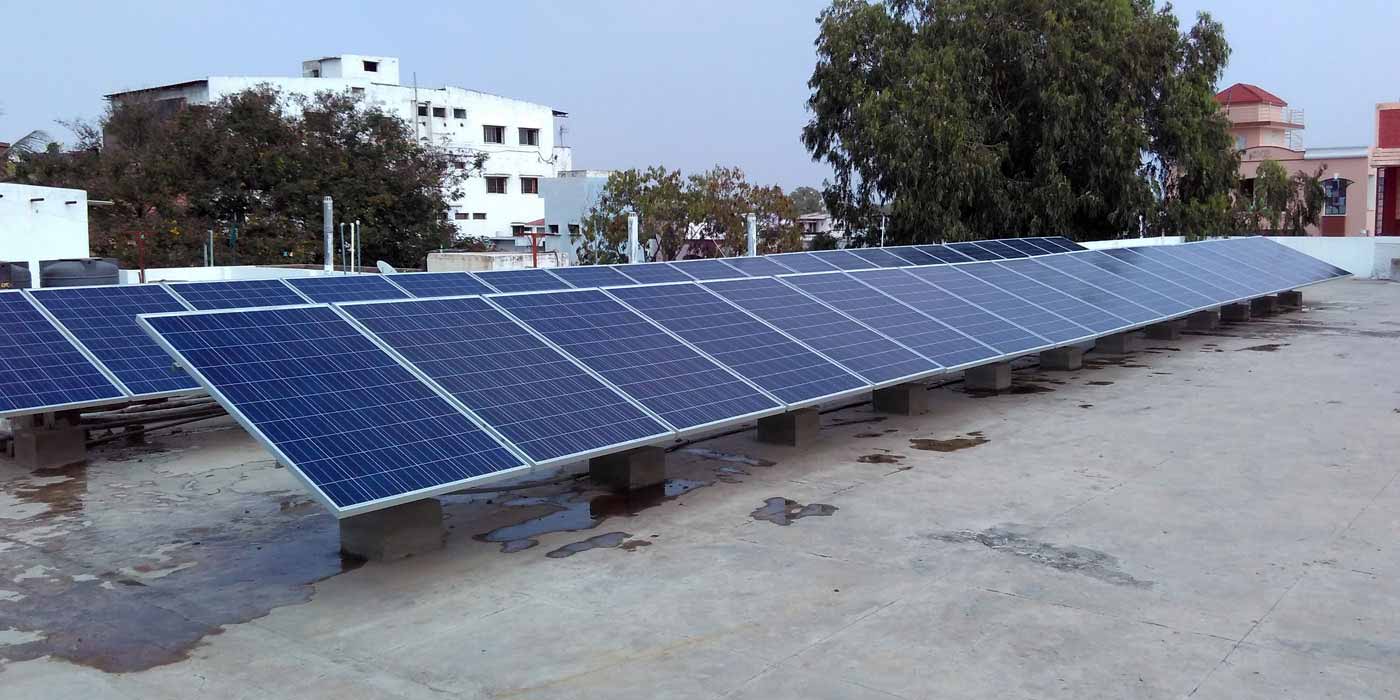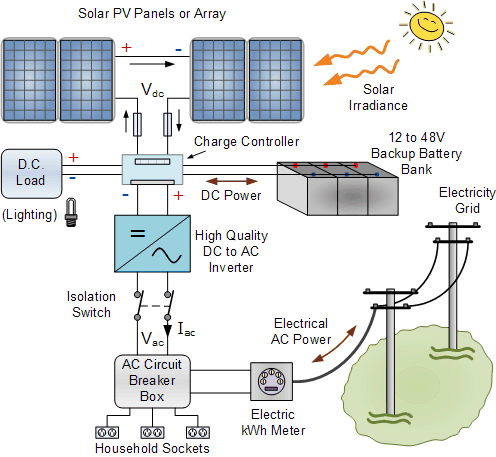
Roof Top - On Grid Solar Solution
A grid-connected photovoltaic power system, or grid-connected PV power system is an electricity generating solar PV power system that is connected to the utility grid. A grid-connected PV system consists of solar panels, one or several inverters, a power conditioning unit and grid connection equipment. They range from small residential and commercial rooftop systems to large utility-scale solar power stations. Unlike stand-alone power systems, a grid-connected system rarely includes an integrated battery solution, as they are still very expensive. When conditions are right, the grid-connected PV system supplies the excess power, beyond consumption by the connected load, to the utility grid.
Flow of Solar Electricty - On Grid

The Grid connected PV systems always have a connection to the public electricity grid via a suitable inverter to convert DC into AC. The main components of Grid tied Solar PV system are Solar Panels, Inverter, Electricity Meter, AC Breaker Panel and Fuses, Safety switches and Cables, utility electricity grid.
1. Solar Panels: Solar Panels convert the clean Sun light into Direct Current (DC) electricity. Photovoltaic modules use light energy (photons) from the Sun to generate electricity through the photovoltaic effect. The majority of modules use wafer-based crystalline silicon cells or thin-film cells. Module electrical connections are made in series to achieve a desired output voltage or in parallel to provide a desired current capability.
2. Inverter: The inverter is the most important part of any grid connected system. The inverter extracts as much DC (direct current) electricity as possible from the PV array and converts it into clean mains AC (alternating current) electricity at the right voltage and frequency for feeding into the grid or for supplying domestic loads.
3. Electricity Meter : The electricity meter also called a Kilowatt hour (kWh) meter is used to record the flow of electricity to and from the grid. Twin kWh meters can be used, one to indicate the electrical energy being consumed and the other to record the solar electricity being sent to the grid. A single bidirectional kWh meter can also be used to indicate the net amount of electricity taken from the grid.
4. AC Breaker Panel & Fuses: The breaker panel or fuse box is the normal type of fuse box provided with a domestic electricity supply and installation with the exception of additional breakers for inverter and/or filter connections.
5. Safety Switches and Cabling: A photovoltaic array will always produce a voltage output in sunlight so it must be possible to disconnect it from the inverter for maintenance or testing. Isolator switches rated for the maximum DC voltage and current of the array and inverter safety switches must be provided separately with easy access to disconnect the system.
6. The Electricity Grid: Finally the electricity grid itself to connect too, because without the utility grid it is not a Grid Connected PV System.
Grid Connected PV System with Battery Storage

PV system with battery storage is basically the same as for the previous grid connected PV system with the addition of the batteries and charge controller. The battery charge controller, determines whether the power generated by the solar panels is needed for home use, to run low voltage equipment and lighting or whether it will charge the deep-cycle backup batteries to be used later on. The DC current leaving the controller passes through the DC to AC inverter, transforming it into electricity usable by general household appliances. Any surplus electricity not being consumed or used by the home can be sent to the electricity companies power grid. It is better to run DC rated lighting and appliances first directly off your solar system before the current is converted to AC from the inverter. This will gain the most efficiency.
Living with a grid connected solar PV system is no different than living with just the normal grid power, except that some or all of the electricity that is consumed comes from the sun. PV solar systems designed for grid connection are usually designed to meet at least half of a homeowners electrical needs. Purchasing a home solar photovoltaic panel array large enough to supply the entire electrical needs of a home would be extremely expensive with the solar array taking up a large amount of space. The solar power generated by a grid connected system is therefore only partial, with the remaining energy being made up by the power company.
The advantage of a Grid Connected PV System, either with or without storage batteries is that on clear blue sunny days, when the photovoltaic system is producing large amounts of current and the home is consuming low energy levels, for example, if you are out of your home all the day working, you’re solar system keeps generating electricity. The excess electricity generated does not go to waste but is fed back into the power grid to be used by your neighbouring homes who unknowingly end up using the clean, renewable energy themselves while making money for you through your “net metering” arrangement.


